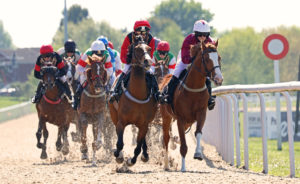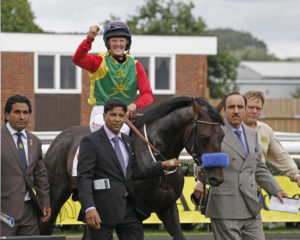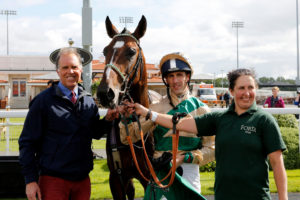The History of Arabian racing in Great Britain: A Sport born of passion
All Arabian racing in Britain takes place under the modified rules of Thoroughbred racing, as defined by racing’s governing body, the British Horseracing Authority (BHA) and has been run by the Arabian Racing Organisation (ARO) since 2000.
During the 1970s, Arabians had already proved successful in long distance and endurance rides, however, the first flat races were not held until 1978, when the first meeting, held at Hawthorn Hill, Berkshire, on 10th July 1978, laid the foundation for a sport that has now become so firmly established that the BHA has seen fit to bring it under its own jurisdiction. That the meeting was held at all was due in no small measure to the efforts and enthusiasm of three people, Valerie Whitehead, and John and Anne Unwin. They shared a deep concern for the image of the Arabian horse in Britain and wanted to introduce racing as a means of testing the ability of the horses being bred.
By the 1981 season, a further five meetings had been added to the calendar, three at Larkhill and one each at Mollington and Costessey. In general, the meeting averaged about six runners a race, but with small spectator turn-outs, financial solvency for Arabian racing was a problem and placed a burden on the Arab Horse Society’s (AHS) funds. Such was the enthusiasm, however, for the sport by those who took part, that at the annual open race meeting in London the following December, 17 people agreed to personally underwrite any loss made in 1982 up to £100 each. The 1981 season also saw the arrival of on-course bookmakers, with then Jockey Club approval.
In 1982 came a major step forward: The Jockey Club (then the governing body for Thoroughbred Horseracing) granted permission for the Society to hold its meetings on licensed racecourses. As a result, after an opening meeting at Larkhill on 26th June, the first meeting to be held on a licensed course took place at Towcester on 10th July.
1984 saw the greatest boost to Arab racing in terms of prestige and publicity as a result of an unprecedented sum of money being offered by the Emirate of Dubai, through its Deputy Ruler and Minister of Finance and Industry for the UAE region, His Highness Sheikh Hamdan bin Rashid al Maktoum. This financial arrangement was the brainchild of Mrs Joan Ratcliff, who became Chairman of the Racing Committee in 1983. With characteristic vision she was able to persuade the authorities of the ruling family of the Emirate of Dubai to support Arabian racing in the United Kingdom in a most generous way, and this support is undiminished to this day. In recognition of his generous and unfailing support of the Arabian racing in Great Britain, HH Sheikh Hamdan bin Rashid Al Maktoum was invited to be Patron of the Arabian Racing Organisation.
The donation offered in 1984 was assigned as prize money for the most important fixture of the season, the Kempton Park meeting designated as the centenary meeting to celebrate the first know races for Arabians run in Europe in 1884. Held on 23rd July, this historic meeting was the highlight of a season of six fixtures. The total prize money offered at the Kempton meeting equalled £25,000. The most valuable race on the card, with a total of £7,500 in prize money, was the Dubai Stakes for Purebred Arabians over a distance of one mile two furlongs.
Expansion was rapid during the mid-1980s; in 1983 the number of horses racing totalled 75; this had rocketed to 179 by 1985, with the number of owners, trainers and jockeys registered increasing at a similar pace. It was partly as a result of this extraordinary growth that the Jockey Club took the decision to bring Arabian racing under its jurisdiction from 1986.
The 1990s were perhaps the most popular times for Arabian racing which was claiming more international appeal. Indeed, there was a fair chance of being balloted out of these very competitive races due to the large number of entries! There were several trainers with decent strings of horses including Gill Duffield, Sarah Kellaway, Don and Liz Harrington, Bill Smith, Gillian Hay, Val Bunting, Wendy Parkin, Bernie Gonsalves, Stuart Shefras, Sue Boorman, Christine Cooper, Tony and Sue Brunton.
The popularity of the sport and the production of good, British bred Arabian horses did not go un-noticed by the Arabian states and many Middle Eastern owners began to purchase horses from British breeders to race and to establish their own breeding stock. Tattersalls, the famous bloodstock auction house, held Arabian sales during this time. This shift from amateur owner/ breeders to a more global structure inevitably meant that there were fewer horses being produced for the domestic market and that it became more difficult for British owners to compete against international clients at the sales.
French and Russian bred horses also started to make an appearance in international races at this time and eventually the French lines would dominate the sport. The Arab Horse Society, determined to help those people who had supported the sport at its outset, aimed to help domestic owners and trainers by adding domestic races and conditions to the programme to help them. The cost to the AHS of running the sport were also coming into play at this time, with racecourse fees rising and a lack of financial support; therefore, in 1999 the Arabian Racing Organisation (ARO) was set up.
In recent memory, HH Sheikh Hamdan has been consistently the most prolific competitor in Arabian racing and has claimed the Leading Owner title over 15 times. Gill Duffield trained successfully for His Highness for years, overseeing horses in both the UK and UAE and training out of Newmarket’s Hamilton Road. The Ruler of Dubai, HH Sheikh Mohammed also raced Arabians in the early part of the Millennium in his famous maroon colours, under the guidance of Bill Smith who is now a member of the Board of Directors of ARO.
Although this new and considerable competition was a challenge to domestic owners and trainers, there were still those taking on the bigger yards and winning. Lesley Hartley had success with the stallion SHOMRAN, and later his pint-sized plucky daughter SHUNAH won scores of races including at Group level. Angela Cook become renown for training CARRACK and CARAVEL (both bred by Joan Ratcliff’s Claverdon Stud): CARRACK won Group races, beating top French horses along the way. Lesley Dunn’s top mare CHATELAINE beat some top French horses as did her son CHATANZ. In later years his son AL REEH JANOOB won 10 races for his owner/breeder Jenny Lees winning from five furlongs to two miles!
The Modern Era
 Today Arabian racing in Britain continues to evolve and progress; the Arabian Racing Organisation works towards further integration with the British Horseracing Authority, especially on matters of bio-security. This is intended to enable, eventually, Arabian horses to be treated in exactly the same way when they go to a racecourse as a Thoroughbred and may eventually see Thoroughbred and Arabian horses trained in the same yards as they are in France. These bio-security measures will hopefully mean a reduction in racecourse fees meaning the sport is more profitable and more money can be put in to prize money.
Today Arabian racing in Britain continues to evolve and progress; the Arabian Racing Organisation works towards further integration with the British Horseracing Authority, especially on matters of bio-security. This is intended to enable, eventually, Arabian horses to be treated in exactly the same way when they go to a racecourse as a Thoroughbred and may eventually see Thoroughbred and Arabian horses trained in the same yards as they are in France. These bio-security measures will hopefully mean a reduction in racecourse fees meaning the sport is more profitable and more money can be put in to prize money.
The focal point of each season is Dubai International Arabian Races Championship which is traditionally held at Newbury Racecourse at the end of July. The meeting attracts runners from all over the world including Europe, UAE, Qatar, USA and Morroco and not only has Group races but handicaps for the smaller owners and trainers.
Gill Duffield has been champion trainer over 10 times and has trained numerous winners including Group 1 performers – SOPHIE DU LOUP, BENGALI D’ALBRET, JIYUSH, AL HIBAAB, NO RISK AL MAURY, MADJANI and KAOLINO – the latter three all now successful stallions in their own right and producing Group winners of their own. Gill retired in 2015 and HH Sheikh Hamdan’s string is now split between James Owen and Phil Collington; both have been extremely successful with James being crowned Champion trainer in 2016 and 2017. Phil took the Champion trainer title in 2018 and trained his first Group winner in his first season, with JAMAAYIL and RADAMES both scoring at the Championship meeting.
Significant success has also been enjoyed by the likes of Peter Hammersley who has been runner up in the trainers’ Championship two years in a row; Adam Newey who has trained three Dubai Day winners (SYRAS GRIS, SHADIYA and KAMIKAZE) as will as Champion Arabian WIKKARA and the first Heritage Arabian Racing Club (HARC) Champion WHISPER in 2015.
Clare Taylor and Delyth Thomas both have trained a significant number of winners with Delyth producing two DIAR winners (NOBLE ATHLETE and JAMAAHIR) as well as Champion mare CALLYMAY in 2016.
Original authorship and reproduced by kind permission of: Paul Simmons, Gillian Newsum, Gillian Duffield and Gillian Hay
Edited for ARO website by Rachael Gowland












